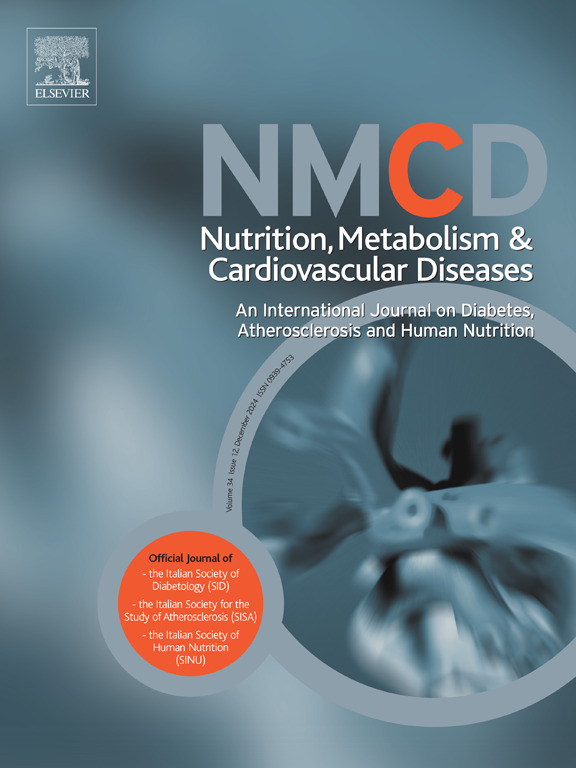LP(a):心血管疾病高风险的新标志。
IF 3.3
3区 医学
Q2 CARDIAC & CARDIOVASCULAR SYSTEMS
Nutrition Metabolism and Cardiovascular Diseases
Pub Date : 2025-03-01
DOI:10.1016/j.numecd.2024.103845
引用次数: 0
摘要
60多年前发现的脂蛋白(a)的生物学功能和在人类疾病中的作用仍未完全了解。载脂蛋白(a)与纤溶酶原的高度同源性最初使我们认为脂蛋白(a)在凝血系统中作为促血栓形成因子发挥着重要作用。多年来,来自生物学、流行病学、遗传学和孟德尔随机化的大量证据表明,Lp(a)是动脉粥样硬化性冠心病、主动脉钙化瓣膜狭窄和缺血性中风的一个致病因素。关于氧化磷脂的作用的实验数据证明了Lp(a)在动脉粥样硬化和主动脉钙化瓣膜狭窄中的积极参与,氧化磷脂是Lp(a)的货物,瓣膜间质细胞中存在Lp(a)受体。在二级预防中,对低密度脂蛋白胆固醇(LDL-C)进行最佳治疗但Lp(a)水平较高的患者显示出残留的心血管风险。迄今为止,影响LDL-C的药物对Lp的影响微乎其微(a)。他汀类药物适度升高,单克隆PCSK9i和Inclisiran适度降低,不足以显著降低Lp相关风险(a)。只有脂蛋白apheresis和obicetrapib(一种CETP新型抑制剂)能分别降低75%和40%的Lp(a)水平。若要使LDL-C降低约40 mg/dl所达到的终生风险降低50%,则Lp(a)应降低约100 mg/dl。正在进行的药物试验,如ASO, sinas,组装抑制剂,也许在未来的基因编辑可以获得这些结果。本文章由计算机程序翻译,如有差异,请以英文原文为准。
LP(a): The new marker of high cardiovascular risk
The biological functions and role in human diseases of lipoprotein (a) discovered more than 60 years ago are still not fully understood. The high homology of apo(a) with plasminogen initially leads us to think of Lp(a) as a player in the coagulation system as pro-thrombotic factor. Over the years, a solid body of evidence from biology, epidemiology and from genetics and mendelian randomization has contributed to identify Lp(a) as a causal factor of atherosclerotic coronary heart disease, aortic calcific valve stenosis and ischaemic stroke. The active involvement of Lp(a) in atherogenesis and aortic calcific valve stenosis has been demonstrated by experimental data regarding the role of oxidized phospholipids, which are the cargo of Lp(a) and the presence of a Lp(a) receptor in valve interstitial cells. In secondary prevention, patients optimally treated for low density lipoprotein cholesterol (LDL-C) but with high Lp(a) levels show a residual cardiovascular risk. To date the LDL-C affecting drugs have a marginal effect on Lp(a). Statins produce a modest increase, monoclonal PCSK9i and Inclisiran a modest decrease not sufficient to reduce significantly the risk associated to Lp(a). Only lipoprotein apheresis and obicetrapib, a CETP novel inhibitor, reduce respectively by 75% and 40% Lp(a) levels. To obtain a lifetime risk reduction of 50% similar to that achieved by reducing LDL-C of about 40 mg/dl, Lp(a) should be reduced of about 100 mg/dl. The ongoing trials on drugs such as ASO, SiRnas, assembly inhibitors and maybe in the future the gene editing could obtain these results.
求助全文
通过发布文献求助,成功后即可免费获取论文全文。
去求助
来源期刊
CiteScore
6.80
自引率
2.60%
发文量
332
审稿时长
57 days
期刊介绍:
Nutrition, Metabolism & Cardiovascular Diseases is a forum designed to focus on the powerful interplay between nutritional and metabolic alterations, and cardiovascular disorders. It aims to be a highly qualified tool to help refine strategies against the nutrition-related epidemics of metabolic and cardiovascular diseases. By presenting original clinical and experimental findings, it introduces readers and authors into a rapidly developing area of clinical and preventive medicine, including also vascular biology. Of particular concern are the origins, the mechanisms and the means to prevent and control diabetes, atherosclerosis, hypertension, and other nutrition-related diseases.

 求助内容:
求助内容: 应助结果提醒方式:
应助结果提醒方式:


